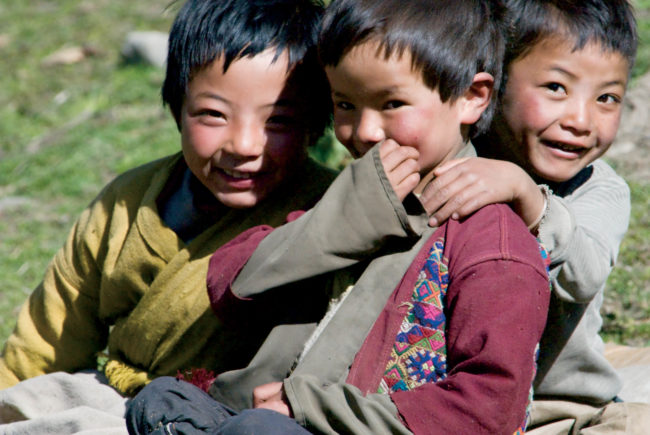Geoffrey Holland speaks with Michael Charles Tobias and Jane Gray Morrison about their latest book, The Theoretical Individual
GH: History seems to follow a pattern that, more or less, distills to ‘two steps forward, one step back’. Issues like voting rights, gender and LGBTQ rights, equitable distribution of wealth, have all been impacted dramatically by individual initiative leading to collective action. When we talk about The Theoretical Individual, are we really talking about encouraging compassion, critical thinking, and assertive leadership skills to galvanize masses of humans to embrace a shared stewardship of the biosphere?

MT/JM: Yes. The instinct to bond with others, and we think it is an instinct, possibly the time-worn amalgamation of behavior that became learned in the wake of so much satisfactory outcomes, is defined by the community. Most primates (baboons being a major exception) do not exceed approximately 150 members. This may have to do with crucial corollaries between bonding and carrying capacity in any biogeographical setting where mathematical ratios brush up against the tragedy of the commons at great peril. Given what we have learned from Thomas Malthus, Adam Smith, Paul and Anne Ehrlich and others, humanity’s greatest challenge – regardless of any number of these so called theoretical individuals – will be our relentless and continuing population explosions within a large remaining patchwork of human communities throughout the world.
Whether vast bonding mechanisms like social media can accelerate the necessary anodynes, assuaging hunger, violence, hatreds… is still hypothetical. There is no theorem that can be demonstrated on the basis, to date, of predictable and successful community engagement via the Internet, for example. Although there is plenty of sociological data to give us encouragement in this instance. Students in Florida, or years ago, forces for democracy in Rumania, to cite obvious examples. But 7.6 billion ungainly largely carnivorous Homo sapiens have far exceeded the Earth’s biological boundaries. The map of pain points our excesses have propounded on others (trillions of other vertebrates murdered for our consumption) is unimaginably gruesome. As a species we know the makings of a Holocaust. Most recently, like a modern-day Hieronymus Bosch, the artist and Auschwitz survivor, Marian Kolodziej has memorialized his own horrifying experiences. Can we halt the ecological holocausts accompanying our propensity to bond into megacity sized accretions, or right wing supremacist parties, etc.? That is the question.
GH: Women are wired for the birthing and nurturing of life. Is the establishment of a firm and level playing field for women a part of creating optimal conditions for transcendent theoretical Individuals?
MT/JM: Of course. This is basic not just to the science that was advanced by an Aristotle and Linnaeus in their studies of botany, sexuality, and the inexorable demographics resulting from such abundant parturition – but the inherent conclusion to human DNA, a minor numeric reminder that we are, except for the 23rd pair of chromosomes which dictates male or female, essentially the same organism. What is so wonderfully different (among multitudinous nuances of every persuasion) are the odd laws of attraction and variations on the theme of fidelity. In violation of that fundamental through-story, oppression of women seeks, in essence, to repudiate gravity.
All ecosystems are in flux but if human ecology is to mature, even to get to a place of basic viability, let alone transcendence of some kind, then we need veneration and humility like never before, as it concerns all females. Their collective traits schools and enshrines the majority of all evolutionary form. That’s not to ignore wasps and bats and flies and all the other essential pollination services that nature has devised. But, rather, to recognize that men are, biologically speaking, almost unessential. Nearly twenty years ago, data was obtained highly suggestive that 70% of all human calorie intake in so called hunting societies, actually comes from the patient gathering of plant materials by women. Any archaeology of napkins would shed stunning light on this fact of matriarchal non-violence.
But ultimately your question poses the critical obvious issue of human rights within mammalian communities, and the quintessential majesty of the umbilical cord as our first link to the Earth and to one another.
We referred to the human population explosions, where boom and bust dynamics are clearly visible in the guises of nutritional illiteracy (famine, malnutrition, inequities around the dinner table), resource scarcities and vast marginalization and suffering. Mitigating these runaway trains of fertility will be dependent on programs like those of United Nations Population Fund, and our unshakeable protections of the female: The provisioning at every level of infrastructure, law, politics, economics, education and equity of their empowerment and equality with males. It is clear that anything short of that will further augment the unprecedented inflictions and sorrows of the Anthropocene, while compounding the moral and practical bankruptcy of the human species.
GH: Consciousness and reality are mysterious constructs, whose true nature remains elusive. How much can we really know about The Theoretical Individual without knowing the true nature of consciousness and reality?
MT/JM: We can’t, but these are just human words with mundane etymologies that have gone astray, or gotten it partly right at least 7.6 billion times, in any given moment amongst the human family. Extrapolate from those billions of individual experiences of reality and thought to the hundreds-of-trillions of other individuals out there with us, in us, all around us. From such a vantage, the “us” can be and has been variously described. Biologists and cosmologists grasp the awesome insignificance of things amid the splendor and significance of all those same things. This paradox is humanity’s own self-awareness and its speaks multitudes, as it should, to the Earth, who clearly listens, or not.
And so there we have it. The greatest uncertainty in our journey, occurring at the very moment when the biological stakes are the most dire in some 65 million years, on this, a most unusual planet. Consciousness and reality are, as we mentioned in the beginning of this conversation, like those revelations from the Upanishads: “Tat Tvam Asi”. Beyond that, every wisdom tradition would do well to study from young engineers who will seek ingenuity through the humanities, and children during their first visit to a national park.

When we speak of theoretical individuals we are most certainly referencing the original world, as it perpetually inspires first contact in children of every species. Don’t be misled to assume that The Theoretical Individual is by some de facto logic speaking merely of humans. It isn’t. The assumption that it is a human is part of the problem. In fact, we are speaking of humans, as we are of social insects, or Blue Whales, or California Redwood Trees with their constellations of co-habitants; living breathing undoubtedly dreaming life forms from several feet below the soil to their nearly 380 feet of discerned height.
GH: Social insects, like ants, termites, and bees, function in a way that suggests a collective consciousness at work. Starlings by the thousands perform aerial maneuvers together with uncanny grace and precision. These murmurations of starlings appear impossible without some sort of collective consciousness that binds the birds, allowing them to perform as one. Is there any indication that humans may have any kind of common thread that binds them, and that could be nurtured to encourage altruistic behavior on a cultural scale?
MT/JM: The strange finale to the human drama encompasses a very curious observation everyone at some point in time likely recognizes: Ignoring pros and cons, feelings, likes and dislikes, the fact remains that we can live in small groups or large groups, but we can also live alone. Biologists are fond of pointing out that nothing lives alone. But in the realm of human experiential diagnostics, there are solitaires, just as there are among many other species. These differing configurations are numerical illusions, because biologists, for all of their opinions, have largely gotten it right. We discuss this in an early chapter of the book with respect to three lost tribes from several thousand years ago in the Tamaulipas State of Mexico, where we documented small clusters of humanity who left a record of their moment on Earth across hundreds of rock walls, and deep within caves. Like others of their kind, they left few handprints, fewer footprints, and seemed to have existed in a perfect realm of isolation. But they were individuals in small, intimate communities, existing in peace.
Well, we can go there in our own time, in our own myriad fashions of thought and expression. It is possible. There is a common theme there which is inextricably the human message, however flawed the steadiness of its heartbeat.
Michael Charles Tobias and Jane Gray Morrison are ecological philosophers and animal liberation activists who have worked for decades to help enrich our understanding of ecosystem dynamics and humanity’s ambiguous presence amid that great orchestra that is nature.
The Theoretical Individual is available in hardcover and ebook formats directly from Springer, or it can be found through Amazon.com, Google Play, and eBooks.com. It might also be available through your local bookstore or library.
The MAHB Blog is a venture of the Millennium Alliance for Humanity and the Biosphere. Questions should be directed to joan@mahbonline.org
MAHB Blog: mahb.stanford.edu/blog/new-nature/
The views and opinions expressed through the MAHB Website are those of the contributing authors and do not necessarily reflect an official position of the MAHB. The MAHB aims to share a range of perspectives and welcomes the discussions that they prompt.
